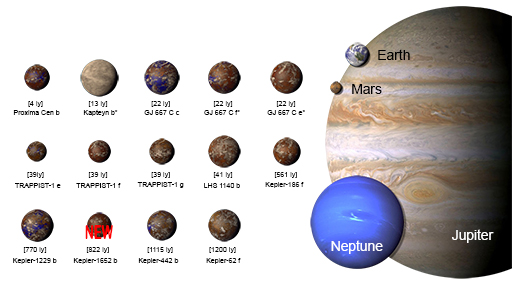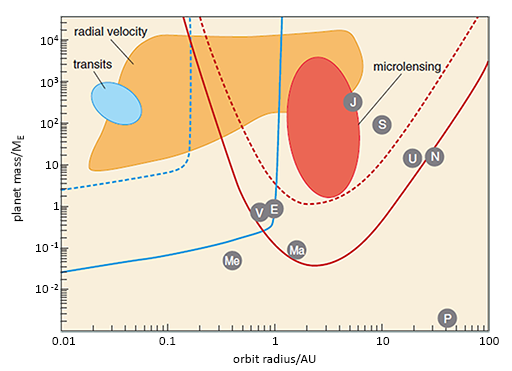6 The habitability of planets
There is continuous research into finding exoplanets outside the Solar System with environments similar to Earth’s. But how is this done?
A range of techniques are used. For example, the measurements of planets can be plotted on a graph similar to Figure 6. Here, the orbital radius is measured in terms of astronomical units (AU). This is the distance from the Earth to the Sun (150 million km). The planet’s mass is measured relative to the mass of the Earth (ME) (6 × 1024 kg).
Using Figure 6, now complete Activity 8.
Activity _unit6.7.1 Activity 8 Exploring the habitability of other planets
Choose the correct answer to the following questions.
a.
Orbit
b.
Orbit radius
c.
Planet mass
d.
Orbit radius/AU
e.
Planet mass/ME
The correct answer is d.
a.
Orbit
b.
Orbit radius
c.
Planet mass
d.
Orbit radius/AU
e.
Planet mass/ME
The correct answer is e.
a.
J
b.
S
c.
E
d.
V
e.
N
The correct answer is c.
a.
J
b.
S
c.
E
d.
V
e.
N
The correct answer is a.
a.
J
b.
Me
c.
E
d.
V
e.
Ma
The correct answer is b.
What makes planets habitable for humans?
You might have heard of the ‘Goldilocks zone’. This is the zone occupied by the Earth in its orbit about the Sun. This zone is neither too close to the Sun – that is, too hot – nor too far away from the Sun – that is, too cold. So, Earth is located where the conditions are just right for life to exist.
In trying to find other planets which are suitable for humans, the Planetary Habitability Laboratory (PHL) aims to map the habitable Universe. It holds the Habitable Exoplanets Catalogue (HEC) which lists and compares potentially habitable exoplanets (Figure 7). Using this information in Figure 7, now complete Activity 9.

Activity _unit6.7.2 Activity 9 Potentially habitable exoplanets
Answer the following questions, choosing one option for each.
a.
Trappist-1 f
b.
Kepler-62 f
c.
GJ 667 C c
d.
Proxima Cen b
e.
Kepler-1229 b
The correct answer is d.
a.
1200 ly
b.
770 ly
c.
1115 ly
d.
2000 ly
e.
39 ly
The correct answer is a.
a.
Trappist-1 f
b.
Kepler-62 f
c.
GJ 667 C c
d.
Proxima Cen b
e.
Kepler-1229 b
The correct answer is c.
Next you will complete the end-of-week quiz.

